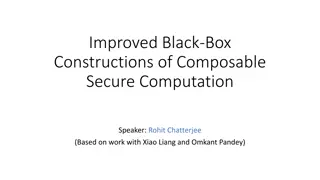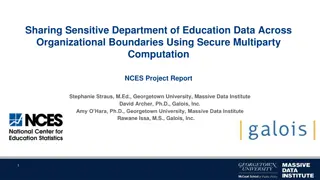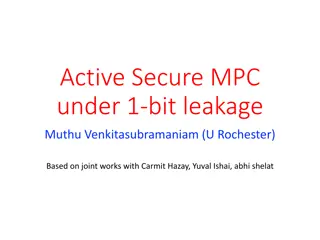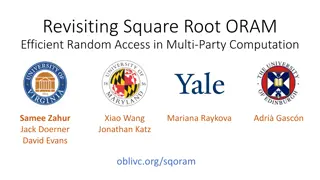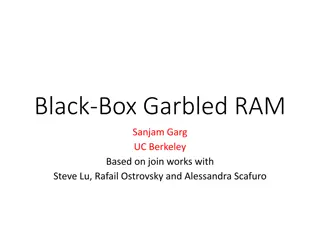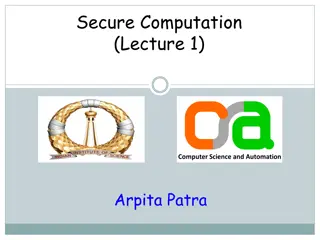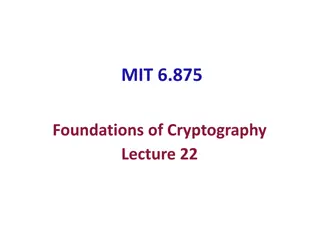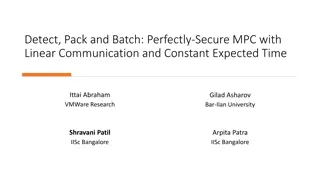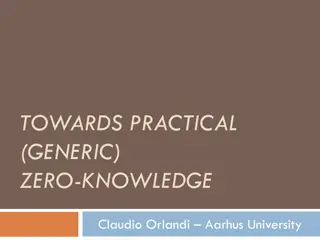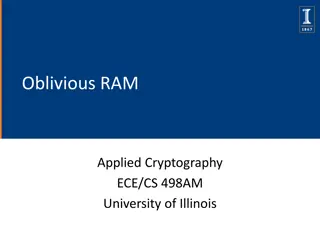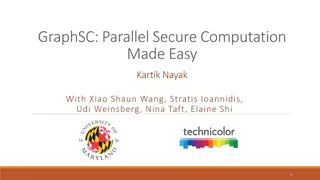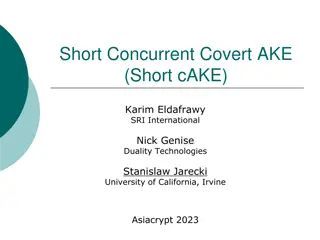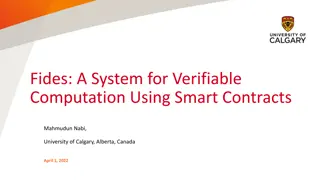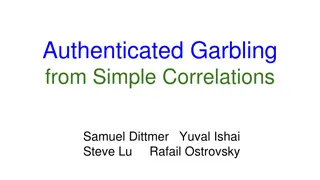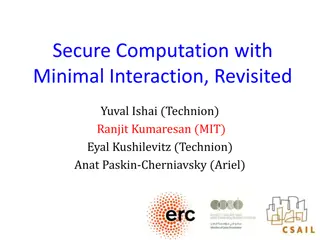Understanding Garbled RAM: A Deep Dive into Secure Computation
Delve into the world of Garbled RAM, a groundbreaking concept that enables secure computation without efficiency loss. Explore the goals, definitions, security aspects, and the distinction between weak and full security. Discover how Garbled RAM ensures data privacy and hides access patterns, providing novel constructions with provable security.
Download Presentation

Please find below an Image/Link to download the presentation.
The content on the website is provided AS IS for your information and personal use only. It may not be sold, licensed, or shared on other websites without obtaining consent from the author. Download presentation by click this link. If you encounter any issues during the download, it is possible that the publisher has removed the file from their server.
E N D
Presentation Transcript
Garbled RAM, Revisited Daniel Wichs (Northeastern University) Joint work with: Craig Gentry, Shai Halevi, Seteve Lu, Rafail Ostrovsky, Mariana Raykova
Goals of Garbled RAM An analogue of Yao garbled circuits [Yao82] that directly garbles Random Access Machines (RAM). Avoid efficiency loss of converting a RAM to a circuit. Google search vs. reading the Internet. First proposed/constructed by [Lu-Ostrovsky 13]. Proof of security contains subtle flaw (circularity problem). This works: new constructions with provable security.
Garbled RAM Definition GData ?,? ? GProg ?,? ? GInput(?, ?) ? Client secret: k Server Eval l ?( ?, ?) ?
Garbled RAM Definition GData ?,? ? GProg ??,?,? ?? GInput(??, ?,?) ?? O(run-time) Client secret: k Server Eval l ?( ??, ??) ?? O(run-time) (even data access pattern is hidden!) Security: server only learns ?1,?2,
Weak vs. Full Security Weak security:May reveal data ?, and data-access pattern of computations. Locations of memory accessed in each step. Values read and written to memory. Compiler: weak full security: Use oblivious RAM [GO96, ] to encode/access memory.
Overview of [Lu-Ostrovsky 13] For now, read-only computation.
Memory Data D= ?[2] ?[1] ?[3] Read location: i read bit CPU Step 1 CPU Step 2 state state
Memory Data D= ?[2] ?[1] ?[3] GProg: Read location: i read bit GInp CPU Step 1 CPU Step 2 garbled circuit state state garbled circuit garbled garbled
GData: ??2,?[2] ??1,?[1] ??3,?[3] ??( ) is a PRF GProg: Read location: i read bit GInp CPU Step 1 CPU Step 2 garbled circuit state state garbled circuit garbled garbled
GData: ??2,?[2] ??1,?[1] ??3,?[3] ??( ) is a PRF Read location: i ?0= ??? (???,0 , ?????0), ?1= ??? (???,1 , ?????1) GProg: read bit GInp CPU Step 1 CPU Step 2 garbled circuit state state garbled circuit PRF Key: k PRF Key: k garbled garbled
Lets try to prove security Read location: i ?0= ??? (???,0 , ?????0), ?1= ??? (???,1 , ?????1) read bit CPU Step 1 CPU Step 2 garbled circuit state state garbled circuit PRF Key: k PRF Key: k garbled garbled
Use security of 1st garbled circuit only learn output ?0= ??? (???,0 , ?????0) ?1= ??? (???,1 , ?????1) read bit CPU Step 2 garbled circuit state labels garbled state PRF Key: k
Use security of 1st garbled circuit only learn output (assume D[i]=1) ?0= ??? (???,0 , ?????0) read bit ?????1 CPU Step 2 garbled circuit state labels garbled state PRF Key: k
Use security of 2nd garbled circuit don t learn PRF key k don t learn ?????0 for read bit Use security of Encryption/PRF ?0= ??? (???,0 , ?????0) read bit ?????1 CPU Step 2 garbled circuit state labels garbled state PRF Key: k
Circularity* Problem! * May appear rectangular
So is it secure? Perhaps, but No proof. No simple circularity assumption on one primitive.
Can we fix it? Yes! Fix 1 : Using identity-based encryption (IBE). Fix 2 : Only use one-way functions. Bigger overhead.
The Fix Public-key instead of symmetric-key encryption. Garbled circuits have hard-coded public key. Break circularity: security of ciphertexts holds even given public-key hard-coded in all garbled circuits. Caveat: need identity-based encryption (IBE) Original solution used Sym-key IBE .
Secret keys for identities (?,? ? ) Garbled Memory ??2,?[2] ??1,?[1] ??3,?[3] Encrypt to identities (i,0) and (i,1) Read location: i ?0= ??? (???,0 , ?????0), ?1= ??? (???,1 , ?????1) read bit CPU Step 1 CPU Step 2 state state Master SK PRF Key: k PRF Key: k
Secret keys for identities (?,? ? ) Garbled Memory ??(1,? 1 ) ??(2,? 2 ) ??(3,? 3 ) Encrypt to identities (i,0) and (i,1) Read location: i ?0= ??????( ?,0 , ?????0) ?1= ??????( ?,1 , ?????1) read bit CPU Step 1 CPU Step 2 state state MPK MPK Master PK
How to allow writes? Compiler Predictably-Timed Writes: Whenever read location i, know its last-write-time u. Any Program Write location j, bit b Read location i read bit CPU Step 1 CPU Step 2 state state
How to allow writes? Garbled memory = { ???? : ?? = (?,?,?)} i = location. j = last-write time of location i. b = bit in location i written in step j. To read location i, need to know last-write time j. Encrypt labels to identities (?,?,0) and (?,?,1) To write location i, at time j Create secret key for ?? = (?,?,?). Need master secret key. Reintroduces circulairty!
How to allow writes? Idea: CPU step j can create secret key for any ID = (j, *,*) but cannot decrypt for identities j < j. Prevents circularity: Ciphertext created by CPU step j maintain semantic security even given secrets contained in all future CPU steps. Need restricted MSK for time-period j. Use hierarchical IBE. By being more careful, can use any IBE.
Timed IBE (TIBE): restricted notion of HIBE. Time-period key ???? can be used to create a single identity secret key for any identity ID = (j, *). Semantic security holds for all other j. Can construct TIBE from any IBE. (see paper) ??? ????=1 ????=3 ????=2 ??(1,????) ??(2,????) ??(3,????)
Garbled Memory initially all keys have time j=0 Invariant: always have ??(?,?,?) where j=last-write-time(i), and b is latest bit. ??(0,1,? 1 ) ??(0,2,? 2 ) ??(0,3,? 3 ) read bit CPU Step 1 CPU Step 2 state state Step j has ???? ???,???2 ???,???1
Garbled Memory ??(0,1,? 1 ) ??(0,2,? 2 ) ??(0,3,? 3 ) u < cur step: semantic security for ?? holds given future ???? Write: i , bit b Read: i, (last-write time: u) ?0= ??????( ?,?,0 , ?????0) ?1= ??????( ?,?,1 , ?????1) ??(?=1,? ,?) read bit CPU Step 1 CPU Step 2 state state ???,???2 ???,???1
Theorem: Assuming Identity Based Encryption (IBE), For any RAM program w. run-time T , data of size N Garbled memory-data is of size: ?(?). Garbled program size, creation/evaluation-time: ? ? ??????? ? . Theorem: Assuming one-way functions, For any constant ? > 0: Garbled memory-data is of size: ?(?). Garbled program size, creation/evaluation-time: ? ? ??.



